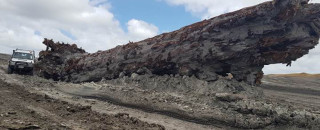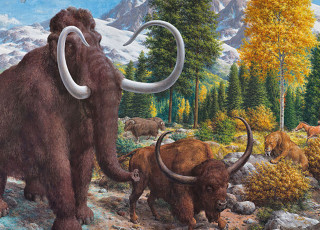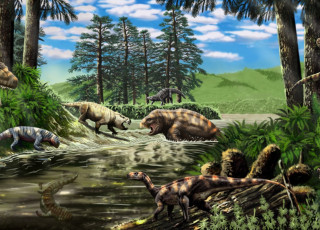Collapse of Earth's Geomagnetic Field 42,000 Years Ago
By Tyler Faith
It’s a safe bet that most of us aren’t overly concerned with Earth’s geomagnetic field—the magnetic field that extends from Earth’s interior into space thanks to currents of molten metal in the planet’s core. Perhaps you have some vague recollections from a science class long ago, or maybe you’ve pondered it while using a compass (it’s the reason the needle points north). But like the oxygen that we breathe, you would miss it if it were gone! The geomagnetic field shields our planet from solar winds, the charged particles emitted by the sun that would otherwise strip away the atmosphere and render life as we know it impossible.
Until recently, I fell squarely in the camp of those who have gone about life unconcerned with the geomagnetic field. Sure, some of my colleagues study the record of Earth’s magnetic field to date ancient sediments (see here), but I study fossil mammals. The geomagnetic field? Not high on my priority list.
That began to change four years ago. At the time, I was working for the University of Queensland in Australia, enjoying lunch with visiting colleague Alan Cooper, a scientist best known for his pioneering work on ancient DNA, and who evidently didn’t feel that footwear was a mealtime requirement. (To be fair, $0.99 flip-flops were the standard in my department, and I was proudly sporting mine). Trained as a molecular biologist, Cooper dabbles in many fields and regularly works with an array of scientists, including archaeologists, paleontologists, and paleoclimatologists—and his team was onto something big.
I’ve spent much of my career studying the recent fossil record of African mammals, and Cooper pressed me: have you ever noticed any interesting changes in African animal populations just before 40,000 years ago? Turns out I have. The faunas from a South African archaeological site that I had studied as a graduate student showed a major shift in the dominant antelope species at this time, surpassing in magnitude the dramatic changes that occurred as Earth’s climate transitioned from a cold glacial phase to the warm interglacial phase that we have been enjoying for the past 12,000 years. But observing a change in the antelope species is not the same as understanding why it occurred, and I was stumped. Cooper suggested that perhaps I should have been paying more attention to the geomagnetic field.
The geomagnetic field is dynamic. The geological record shows that its strength has varied through time, and that the poles have occasionally reversed (i.e., such that the north arrow on your compass would point in the opposite direction). New evidence published in Science by Cooper and an international team (including yours truly), argues that the weakening and subsequent reversal of Earth’s geomagnetic field beginning approximately 42,000 years ago triggered dramatic climate shifts, and fueled ecological change on a global scale.
This geomagnetic reversal—known as the Laschamps Excursion—has been observed before in ancient sedimentary records, but it has been notoriously difficult to date, posing a challenge for understanding its consequences. We were able to overcome this challenge thanks to a sub-fossil kauri tree exquisitely preserved in the waterlogged sediments of Ngāwhā Springs in New Zealand (see photograph). The massive tree in question—with a trunk spanning more than 8 feet across—lived through the Laschamps Excursion, and detailed chemical analysis of its rings made it possible to precisely measure, and securely date, the surge in atmospheric radiocarbon levels caused by the collapse of the geomagnetic field. This provided the critical link that allowed us to match this event to records of paleoenvironmental change from caves, ice cores, and peat bogs across the globe. Paired with global climate models, it became clear that weakening of geomagnetic field could account for global-scale shifts in Earth’s climate, including, for example, shifts that led to an expansion of glaciers and ice sheets here in North America.
The most substantial climatic and environmental changes began during the ~900 years prior to the reversal of Earth’s poles. At this time, the geomagnetic field dropped to less than 6% of its present-day strength, meaning that unfiltered radiation from space effectively fried our ozone layer. Besides triggering climatic change, ultraviolet radiation at the Earth’s surface (the reason we put on sunscreen in the summer) would have surged to potentially dangerous levels. How dangerous? We suggest that it is no coincidence that this weakening of the geomagnetic field—now precisely dated to 42.4 to 41.5 thousand year ago—is associated with the last gasp of the Neanderthals in western Europe and the last appearances of Pleistocene megafauna in Australia, including giant kangaroos and the so-called marsupial rhino.
Human populations clearly escaped their fate, and archaeological evidence may suggest why. The decline of the geomagnetic field is associated with the sudden appearance and dramatic increase in artwork on the walls of caves around the world (e.g., in Europe and Island Southeast Asia). Those caves, we propose, would have provided important shelter from UV radiation. There is parallel archaeological evidence for increased use of red ocher, a pigment commonly used in cave art and which also happens to be an effective sunscreen.
As with many scientific discoveries, our work poses more questions than answers. The Laschamps Excursion was not unique—geomagnetic reversals happened throughout Earth’s history. Did these also trigger global-scale climate changes? Did extinctions ensue? And what—if any—are the implications for our own evolutionary history? I can’t give you the answers to those questions yet, but I have an inkling they will be forthcoming. Just as I hope to have inspired you to think a bit more about the geomagnetic field (yes, it’s appropriate to include on your Thankful List every Thanksgiving!), our work will no doubt lead many of my colleagues to do the same, and to begin looking at the past with a fresh set of eyes.
Tyler Faith is a paleoecologist and curator of archaeology at the Natural History Museum of Utah, and associate professor of anthropology at the University of Utah. The Natural History Museum of Utah is part of the University of Utah in Salt Lake City. Our mission is to illuminate the natural world and the place of humans within it. In addition to housing outstanding exhibits for the public, NHMU is a research museum. Learn more about NHMU.


